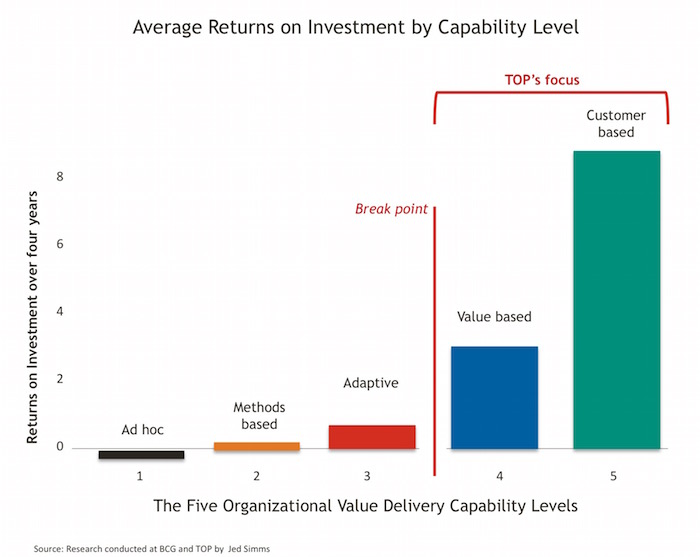The Ship on the Side of the Technology Barnacle
How companies need to look further than technology to improve productivity
Technology is sexy. These days it looks good, is full of promise and there are many acolytes – vendors, consultants, implementers – more than willing to encourage managers to buy up big.
And management does buy the promises and hopes. Billions are spent each year on “CRM systems” or “Supply Chain Systems” or whatever systems – investing in technology in the hope of realizing productivity gains and more.
Commentators recommend increased investment in technology as the answer to the productivity challenge. But, despite the billions in expenditure, productivity has not improved. So, what goes wrong?
The technology is the easy bit. Our research found that, provided the systems are designed for the job in hand, whether you buy technology brand 'A' or brand 'B' makes little-to-no difference. (Well, that’s put the whole technology industry offside!)
The importance of your capability
But how you install it makes all of the difference, Your organization’s level of “value delivery capability” will determine the results you generate from your technology investments. The investment is the barnacle, your value delivery capability is the ship that will deliver the goods—or sink you.
Our research when at BCG and continued at TOP found that two or more companies in the same industry installing the same computer hardware and software generated wildly different results – from negative failures to astoundingly positive gains. Why? The industry and technology were the same, we found that the difference was in how the technology was adopted, installed and used.
Now we’re not talking here about one company having ‘better project management’ than another – for all intents and purposes project managers have little impact on the results. Project managers are like taxi drivers – they’ll take you where you ask them to go; some more efficiently or faster than others, but most will get you to your destination. (Well, that’s put the whole project management fraternity offside too!)
The critical question for any taxi driver is, “What’s the destination?”
The answer to this question is the answer to why similar companies with identical technology investments generate different results – some companies were capable of clearly specifying their desired business outcomes and then delivering them to generate exceptional results from their investments, but most organizations were not.
The nature of your capability
Now the concept of a ‘value delivery capability’ needs to be explained – especially as the word ‘capability’ has been misused for years.
A ‘capability’ is an organizational attribute – only organizations can be capable. To be capable requires having an aligned, attuned and effectively operated set of processes, policies, competencies, measurement systems, supporting cultures, systems and more that all work together effectively to produce the desired results.
Manufacturing firms need to be capable in manufacturing and logistics. Retailers need to be capable in store operation, logistics and buying, for example. These are the capabilities these firms have to excel at to be successful.
There are other aspects of the business - e.g. expenses reimbursement - where the organization needs to be efficient but does not need to be highly capable.
Delivering value from projects, even just delivering projects, are not areas that most organizations have seen they need to be capable in. They see themselves as running the business with some projects on the side. However, this is not the case, and it is this type of thinking about investment projects that produces poor results and little to no increases in productivity from technology investments.
All businesses have two concurrent streams of activities that they need to be capable in — their core business and value-driven change (investment projects). If you cannot change and adopt new technology or new ways of working quickly and effectively you are at a competitive disadvantage.
The returns on your capability
Or to put a more positive slant on it – organizations with higher value delivery capability levels generate up to eight (8) times the returns from the same level of investment expenditure. (Source: BCG research) Over time their EBIT can be 90 times greater than those that struggle to change (Source: McKinsey). Now these are dramatic figures.

Your organisation’s level of “value delivery capability” is the difference between delivering average-to-poor results and highly positive-to-exceptional results. Yet most organisations have no idea what their ‘value delivery capability’ level is.
Why does this matter? Your capability level determines the types of investments you can successfully undertake and deliver.
The key word here is ‘successfully’. Anyone can start a project of any size or type — but the value and returns only come when you deliver the outcomes and benefits. And to deliver the outcomes and benefits you need to successfully deliver the project AND all of the other necessary activities and results. For larger, more complex project investments, successful delivery can require a level of capability beyond your organization’s current level.
When you take on investments beyond your level of capability they go over time, over budget and get de-scoped so as to enable them to finally deliver ‘something’. Sound familiar?
So, while the technology is sexy and easy to buy — the value is in how it is adopted, installed and used. How it is used is determined by how well the organization can define its needs, identify the available value, optimize the investment, manage the change progressively and reap the benefits.
However, most organizations currently
- skip defining their needs (we’ll change the firm to fit the software),
- miss much of the value (the business case is primarily focused only on the costs),
- overstate the investment (as they don’t have the processes or information to optimize the investment),
- minimize the change activities
- and then wonder where the benefits went (if they’re measuring at all by this stage). Not a pretty sight.
In conclusion
Our message is simple and clear — if you want to leverage technology to increase your productivity, you need to get the maximum amount possible from your technology (and all other types of) investments – you need to focus on and develop your organization's ‘value delivery capability’. Otherwise you might be better off not investing at all (which is the case about 40% of the time.) Disturbing but true.
And remember, if you give your taxi driver the wrong destination, an excellent taxi driver may only get you there faster and at lower cost.
Your value delivery capability is your "investment ship", the project manager is "the pilot" and the technology will only be a barnacle on the side of the ship unless you are capable of making it an extra propeller to drive your ship forward to increased productivity.



